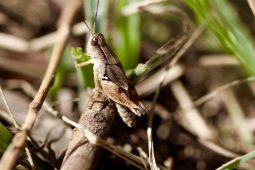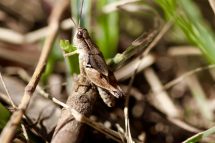
A wingless grasshopper eating

A wingless grasshopper eating
The Australian native grasshopper known as the wingless grasshopper is a common pest of pastures and crops in Australia. Adult wingless grasshoppers can cause serious damage to pasture, and compete with livestock for green clover in summer when green pasture is in short supply. In the last 20 years, it has become a major pest of tree nurseries, including native eucalyptus, and commercially important crops like grapes, vegetables and fruit trees. There are cyclical outbreaks recorded every four or five years, often during unusually dry weather.
In Australia, are predicting a 0.4-2.0°C increase in annual average temperature by 2030, while agricultural land use is expanding, providing a greater area that could be affected by grasshopper outbreaks.
Macquarie University researchers set out to discover whether increasing temperatures will affect the movement and spread of this pest, and how the wingless grasshopper is adapting to the diversity of environmental conditions it occurs in. The results are published in .
To investigate this, they gathered genomic data from grasshoppers collected across a 900km area of New South Wales (including coastal and alpine regions). Higher mean annual temperatures, agricultural land, pastures and rural areas were found to enable high gene flow, and therefore increase the movement of grasshoppers within NSW. On the other hand, urban areas and water bodies reduced their ability to spread.
Although there was considerable mixing between individuals over hundreds of kilometres, the wingless grasshopper shows signs of physical adaptation, like changes in body size and the pattern of stripes, as well as adaptation to local environments. The researchers identified temperature as playing a key role in body size variation and genetic adaptation to different environmental conditions. The genomic analysis detected adaptive genes involved in the perception of environmental cues, UV shielding, and detoxification of plant metabolites, and these genes were found to be favoured in certain areas, indicating local adaptation. Sonu Yadav, lead author of the study says, “The world is warming up and helping some species more than others. This is one of them.”
This study indicates that this agricultural pest has high potential to adapt to variable and changing environments. Therefore, with ongoing climate and land use change, this species is likely to be favoured, potentially allowing for more severe outbreaks of this species, and an increase in the economic damage it may cause. The species’ potential to spread widely and adapt to different environments means it may become a more serious pest in the future as temperatures become warmer, and agricultural land use expands.







